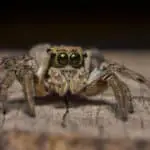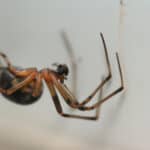One of the most interesting aspects of spiders is their webs. And this is, of course, no coincidence since those intricate, beautiful webs are so mysterious and awe-inspiring.
But what about tarantulas, they are pretty big, so, do they make really big webs, or is this something that they will not bother with?
Do tarantulas make webs? Tarantulas do make webs, but they do not make webs for catching food. Tarantulas will make webs before molting or while eating. They will also make webs for securing their burrows and their habitable area, among other reasons. Some tarantulas, however, may not make any webs at all.
Tarantulas are very complicated creatures. They do not follow anyone’s rules—only their own and frequently may act very strangely, especially when it comes to making webs. Below I share with you more details.

Do All Spiders Make Webs?
To every rule and principle in life, there are always exceptions. So do all spiders make webs, or is this a privilege reserved only for a select few?
All spiders can create silk, which is the material used for making webs. However, not all spiders will use that silk to create webs. In other words, although all spiders have the capability to make webs, not all of them will.
The reasoning behind this is simple.
Spiders use their silk for different purposes—some will use it to make a web while others can use it for building burrows, nests, and cocoons; Sometimes, they will use it for safety draglines, or while ballooning, and for egg sac protection and wrapping prey.
Experts believe that spiders can produce silk with varying strength and elasticity, which can be used for different purposes.
This means that tarantulas, too, can create silk that can be used for the making of webs. However, the important question that needs to be answered is, how do tarantulas use their webs?
Also read: Do Spiders Go Back to Their Web?
Do All Tarantulas Make Webs?
Beginner owners may get worried about their tarantulas when they see that it does not weave many webs, if any at all. However, there is nothing to worry about, as this is completely normal.
Let me explain.
Not all tarantulas will make webs. Depending on the species, some tarantulas will spin a lot of webbings while others will not make any at all.
So if this is a behavior that you want your tarantula to exhibit (or not), you should make sure to do the necessary research in order to purchase the right species of tarantula.
If you want a tarantula that will make webs, then you should consider getting an Arboreal. Arboreal tarantulas live above the ground hence why they are more likely to make intricate webbings.
Below I have listed some of the species of tarantulas that make the most webbing:
- Avicularia spp.
- Avicularia avicularia.
- Chilobrachys paviei.
- Chromatopelma cyaneopubescens.
- Pterinochilus murinus.
- Grammostola rosea.
- Psalmopoeus irminia.
- Poecilotheria regalis.
Ground-dwelling tarantulas are usually not heavy webbers. They will very rarely make webs. In most cases, they may make some tiny webs in their burrows to secure the walls or on the ground.
Below I have listed some of the species of tarantulas that do not make a lot of webs:
- Grammostola pulchra.
- Hysterocrates gigas.
- Nhandu chromatus.
- Aphonopelma chalcodes.
- Pelinobius muticus.
- Haplopelma lividum.
- Brachypelma
- Acanthoscurria geniculata.
What Do Tarantula Webs Look Like?
I am sure you have seen those circular, spiral-shaped, perfect symmetry webs that spiders like to make—I am sorry to disappoint, but tarantula webs are nothing like that.
Tarantula webs are like cobwebs. They are patchy, thick, messy, and often do not follow any particular pattern or shape. Tarantula webs usually serve different purposes, and there is no need for their web to be as delicate and symmetrical.
When Will Tarantulas Make Webs?
There are different times when and reasons why tarantulas will make webs.
When Molting
It is almost guaranteed that a tarantula will make a molting mat when it is nearing a molt.
This makes the whole process of molting a lot more comfortable and safer for them.
While Feeding
Tarantulas don’t use their webs to catch their prey. Technically speaking, the tarantula’s webs can help the spider catch some food that has wandered by mistake into the web; however, this is not the main purpose of their web.
I am sure you have heard of the tarantulas’ happy dance. And if you haven’t, here’s the thing.
After tarantulas catch their prey, they will perform what is referred to by many as a happy dance.
It’s not that the tarantula is actually happy; it is simply how it prepares its food. It just so happens that it looks like a tiny happy dance.
The tarantula will lay a small amount of web on the ground and cover its prey while moving in a circular pattern around the prey. This helps the tarantula hold the prey in one place as it digests it.
There are also other theories that tarantulas do that for hygiene purposes or as a way to preserve their food, too.
Some tarantulas will make very tiny webs on the ground for the purpose of easier movement and finding and catching food.
For ‘Decoration’
Some ground-dwelling tarantulas will cover the walls of their burrows with webs in order to secure them and create intricate underground caverns.
Arboreal tarantulas, on the other hand, will create plenty of webbings above ground, around the corners of the tank, and on any plants and structure, including the lid of the tank.
Gender-Related Purposes
There are a few other reasons why a tarantula will make webs that are more gender-specific.
Male tarantulas are known to make a “sperm web”. When they see their mature male tarantula first making its sperm web, a lot of people will think it is acting very strange. However, this is a normal process.
Female tarantulas, on the other hand, will often weave webs to protect their egg sacs.
When Wandering Off
Tarantulas will also use their webs as safety draglines that they can use to find their way back and around places.
Usually, male tarantulas will explore their surroundings more than females, mainly because they look for food or a suitable female.
Interestingly enough, it is believed that male tarantulas can discern between female and male draglines and even make a good guess on the tarantula’s health condition.
Why Will a Tarantula Not Make Webs?
There Is No Need for a Web
Think of your tarantula as an incredibly practical animal—if it doesn’t see a reason to make webs, it will not make it. Spinning a web takes a lot of energy and resources, and a tarantula will not waste its energy if there is no gain for its survival.
Of course, this is not a bad thing, as it most likely means that the tarantula feels safe and secure.
Sometimes it can take a really long time before a tarantula decides to start making webs—one, two, three years, or even longer.
Poor Living Conditions
If there is some kind of a problem with the tarantula’s terrarium, it may decide not to make webs.
If there is not enough structure in the tank, the tarantula may not be able to make the web as nothing will support it.
Problems with humidity and temperature, lack of substrate and structure like plants, rocks, hiding places, can also discourage a tarantula from making webs.
Sickness
If the tarantula does not have access to enough food or water, this can make it too weak to spin a web.
The tarantula may not be capable of spinning a web if its legs have been injured, too.
Do Tarantulas Eat Their Webs?
A lot of spiders do eat their webs, and tarantulas, too, may eat their webs.
However, this behavior is rarely observed, and it can occur only in times of severe lack of food, during captivity, and while eating their prey.
Is It Bad to Destroy a Tarantula’s Web?
Due to one thing or another, owners can end up destroying or seriously messing up large parts of their tarantula’s web. Naturally, this can cause a lot of worry about whether or not it will be bad for the tarantula.
Tarantulas are wild animals. In the wild, their webs can and most certainly will, at some point, get damaged or totally destroyed. The tarantula may get scared at first due to the unexpected event, but this is nothing that it cannot cope with. The tarantula will simply rebuild its web.
Because of that, some owners will even damage and destroy small parts of their tarantula’s webs in order to stimulate their tarantula to make more webs. Others will destroy parts of the web that have gone yellow, or if it is too thick that the food cannot reach the tarantula.
That being said, destroying a tarantula’s webs too often can stress it out.
Can You Encourage a Tarantula to Make Webs?
A tarantula will do what it wants to do; this is a very individual matter. Even some of the tarantulas known for making webs may decide they are not interested in making any webs.
A good example illustrating that is the Pterinochilus murinus (the Orange Baboon tarantula). Some OBTs may spin a lot of webs while others will make little or even no webs at all.
In the majority of cases, you cannot do anything to force your tarantula to make webs. However, there are some ways that you may be able to stimulate it to make some webs by providing it a light source from above (some tarantulas will make sort of a tanning webbing, which they will use to stay in the light) or destroying small parts of its web.
Adding more fake plants, structure, or dry leaves can also encourage some tarantulas to make more webs.








